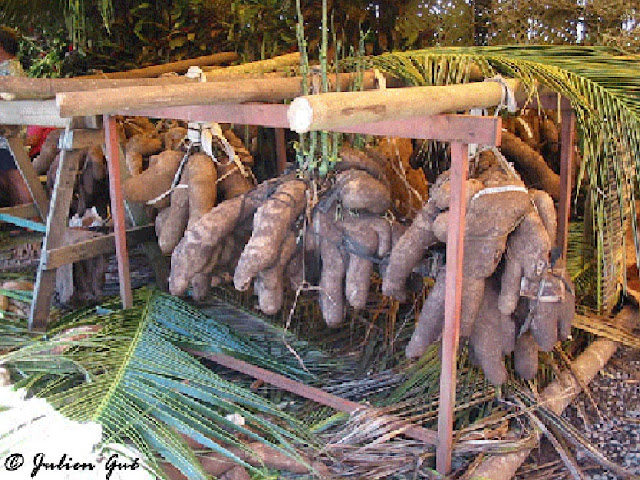|
|
Polynesian specialties
Traditional
Tahitian cooking or Ma'a Tahiti,
incorporates many starchy foods such as taro, yam, ufi, tarua, sweet potato...
Tahiti
cuisine excels by soft and subtle flavors owed both to product quality as
preparing and cooking practices.
If each of
the five Polynesian archipelagoes offers its own specialties, included
ingredients are almost the same: lot of fishes, a little meats, the whole range
of vegetables and tropical fruits.
Meats and fishes edible in Tahiti
The
Polynesian staple food comes from the sea. Thus fish and shellfish pride upon most
local recipes. Fishes are classified in two broad categories: high seas fish
and lagoon-fish. Freshwater shrimp species called “chevrette” (prawn) delight by itself the local cookery.
 |
| Wonderful fishes of Polynesian lagoons |
Before the
cold chain allowed the massive importation of beef (ox) or mutton (sheep) the
only meats consumed in Polynesia were chicken and feral pig.
Until
recently, the most popular dish was turtle flesh. This uptake is strictly
forbidden and severely repressed now.
Polynesian vegetables
If today the
rice became the main component of daily meals, the generous nature provides
many food accompaniments, charm of Polynesian cooking. The main one, uru (fruit of the breadfruit tree), has
long been a basic food of the Polynesians. There are about forty different
varieties.
Nowadays it’s
strongly challenged by taro, because this tuber grows easily in swampy coastal
areas. Its root is used as such, and so the young leaves called pota. In Marquesas, the fermented
seasoned paste is named popoi.
 |
| Taro, the magic root |
Taro is also
used for the preparation of poe, a
very popular sweet. At last, one of the many kinds of taro is grown for its
leaves, eaten as spinach called: fafa.
Then again, fe'i,
yams and sweet potatoes add to the range of accompaniments. The fe'i is a sort of banana that is eaten
cooked only.
Insular fruits
The coconut
is omnipresent in the Polynesian gastronomy, with its flesh and milk.
Local fruits
should be distinguished from those more recently imported. Among the former,
furthermore coconut and uru already mentioned, there are the ambarella ("cythera apple or vi Tahiti") and the mape.
Numerous imported fruit superbly adapted to these climates. So too does with
banana, citrus, pineapple, papaya and mango.
Tahitian traditional cooking
Back to olden days, grilling, baking,
stewing and boiling are only used for cooking. Hence, fine
sweet flavors gastronomy highlights the particular taste of each product
entering the composition of a dish.
The most known of traditional Polynesian
dishes is raw fish. In fact,
this term is unfit, as the fish is marinated a few
hours in a lime, coconut milk,
and various spices with vegetables chopped very finely preparation. Like the most national dishes, there are as many recipes as
families or almost.
 |
| All kinds of fruits: common or strange |
Today the ahima'a (Tahitian oven) remains the top
of the Polynesian gastronomy: it is only built for festive meals because of the
time needed to set up. It’s a full meal once. Ahima'a backs in the mists of ma'ohi time. "Ahi" means fire and Ma'a,
food. All foods are stewed in a large pit dug in the ground. The wood and
porous volcanic stones are laid out before lighting the fire. When the embers
are red foods are carefully placed, wrapped in banana tree leaves or inside coconut
sheets baskets summarily braided.
Among the
most popular dishes that compose an ahima’a:
fafa chicken, fish, suckling pig, shrimp and lobster, different po'e (banana, papaya...) and the full
range of local vegetables.
All that is
covered with banana leaves or purau
(tree of hibiscus tiliaceui). A final layer of soil ensures the tightness of
the oven. Four to six hours are necessary for an optimal cooking.
A great
jubilation punctuated by songs while opening the oven. The various dishes are arrayed in umete (wooden dish) on large tables,
alongside raw fish and fafaru. The fafaru is a preparation of fermented raw
fish in seawater. Formerly, Polynesians ate it and used the water for seasoning
other dishes. But if the population of these islands likes fafaru, few visitors appreciate it. Its smell greatly influences
their judgment.
 |
| Fruits and vegetables, for every taste |
Even so,
come to Polynesia and not taste fafaru would
like to go to France and not eat cheese!
An article
of Julien Gué
Translated from French by Vanaa Teriitehau
Copyright
Julien Gué. Ask for the author’s agreement before any reproduction of the
text or the images on Internet or traditional press.



Aucun commentaire :
Enregistrer un commentaire
Cet article vous a fait réagir ? Partagez vos réactions ici :